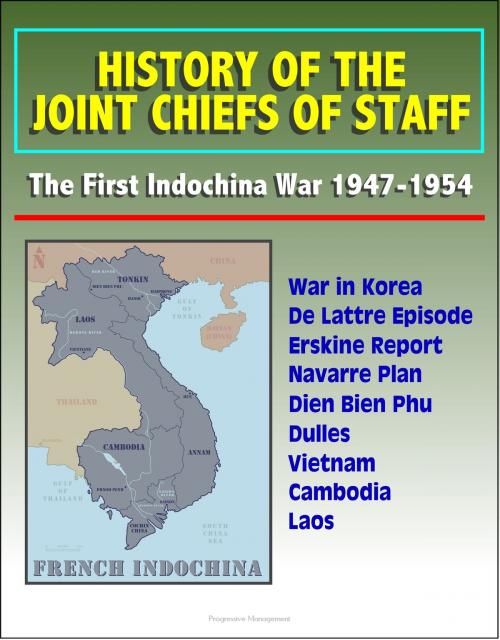History of the Joint Chiefs of Staff: The First Indochina War 1947-1954 - War in Korea, De Lattre Episode, Erskine Report, Navarre Plan, Dien Bien Phu, Dulles, Vietnam, Cambodia, Laos
Nonfiction, History, Military, Vietnam War, Asian| Author: | Progressive Management | ISBN: | 9781301566228 |
| Publisher: | Progressive Management | Publication: | September 29, 2013 |
| Imprint: | Smashwords Edition | Language: | English |
| Author: | Progressive Management |
| ISBN: | 9781301566228 |
| Publisher: | Progressive Management |
| Publication: | September 29, 2013 |
| Imprint: | Smashwords Edition |
| Language: | English |
This volume describes those JCS activities related to the war in Indochina during the period 1947-1954. One of the results of the warfare that raged in Southeast Asia in the late 1940s and early 1950s was to put Vietnam on the map. The decolonization of French Indochina left the region divided into four independent states: North Vietnam, South Vietnam, Cambodia, and Laos. Officially known as "Annamites," the Vietnamese, the major ethnic group in Indochina, were largely settled in three territories: Tonkin in the north, Annam in the center, and Cochin in the south, with Hanoi, Hue, and Saigon (since 1975 Ho Chi Minh City) as the respective capitals. Cambodia and Laos were included with these among the five territories of Indochina. When a provisional government in Hanoi declared the independence of the "Democratic Republic of Viet Nam" (DRV) on 2 September 1945, it claimed to mark the culmination of generations of political struggle to secure a national identity for the Vietnamese people. The war that followed between the communist-led forces of the DRV and the forces of the French Union would lead to the creation of the two states, each claiming to embody this Vietnamese national identity.
For the United States, the Second World War had brought new knowledge of Indochina and its problems. The Americans in Indochina at the time managed to disappoint the expectations of both sides in the impending struggle, but the military services managed to extricate themselves with minimal cost. As between the combatants, the French and the Viet Minh insurgents, America had every reason to avoid involvement until the situation came to be seen as a communist threat to all of Southeast Asia. The preferred solution would have been to win the support of the Vietnamese people to resist that threat. But the communist-led Viet Minh seemed to most Vietnamese as the only force that truly represented the cause of national independence. This left the military forces of the French Union as the primary means to hold Indochina. France, with all its troubles, was a crucial ally, especially in holding Europe against Soviet power. The problem was that Indochina was drawing off some of France's best soldiers and sapping that nation's morale. The dilemma could only be solved by a seemingly unattainable victory or by abandoning an Asian empire. For the United States and for the Joint Chiefs of Staff, the years from 1947 to 1954 were a period when these problems slowly grew in importance. Efforts to build a Vietnamese army bore little fruit. If the French gave up, the question of direct American intervention would arise. The potential engagement of US armed forces in a land war in Southeast Asia was a daunting prospect. But there were dangers to any alternative strategy. The problem reached crisis proportions in the early months of 1954, when dangers of a serious split with a valuable ally, the loss of a strategically crucial region to communism, or even a major war with the communist bloc all seemed to come together.
- World War II and the Coming of the Indochina War * 2. Stalemate and US Noninvolvement * 3. Origins of American Involvement, June 1949-June 1950 * 4. Impact of War in Korea, June 1950-January 1951 * 5. The De Lattre Episode, 1951 * 6. The Truman Administration's Struggle, 1952 * 7. The Eisenhower Administration and the Navarre Plan, 1953 * 8. Dien Bien Phu, Bermuda, and Berlin, November 1953-March 1954 * 9. Prelude to Geneva, March-May 1954 * 10. Geneva and the End of Intervention * 11. Toward a New Alliance
- World War II and the Coming of the Indochina War * French Indochina and the Coming of the Pacific War * The Formation of the Viet Minh * America and Indochina, 1942-1945 * Crisis and Policy * The French Return and the Americans Depart * 2. Stalemate and US Noninvolvement * Military Situation in the Spring of 1947 * The French Break with the Viet Minh * The Bao Dai Plan
This volume describes those JCS activities related to the war in Indochina during the period 1947-1954. One of the results of the warfare that raged in Southeast Asia in the late 1940s and early 1950s was to put Vietnam on the map. The decolonization of French Indochina left the region divided into four independent states: North Vietnam, South Vietnam, Cambodia, and Laos. Officially known as "Annamites," the Vietnamese, the major ethnic group in Indochina, were largely settled in three territories: Tonkin in the north, Annam in the center, and Cochin in the south, with Hanoi, Hue, and Saigon (since 1975 Ho Chi Minh City) as the respective capitals. Cambodia and Laos were included with these among the five territories of Indochina. When a provisional government in Hanoi declared the independence of the "Democratic Republic of Viet Nam" (DRV) on 2 September 1945, it claimed to mark the culmination of generations of political struggle to secure a national identity for the Vietnamese people. The war that followed between the communist-led forces of the DRV and the forces of the French Union would lead to the creation of the two states, each claiming to embody this Vietnamese national identity.
For the United States, the Second World War had brought new knowledge of Indochina and its problems. The Americans in Indochina at the time managed to disappoint the expectations of both sides in the impending struggle, but the military services managed to extricate themselves with minimal cost. As between the combatants, the French and the Viet Minh insurgents, America had every reason to avoid involvement until the situation came to be seen as a communist threat to all of Southeast Asia. The preferred solution would have been to win the support of the Vietnamese people to resist that threat. But the communist-led Viet Minh seemed to most Vietnamese as the only force that truly represented the cause of national independence. This left the military forces of the French Union as the primary means to hold Indochina. France, with all its troubles, was a crucial ally, especially in holding Europe against Soviet power. The problem was that Indochina was drawing off some of France's best soldiers and sapping that nation's morale. The dilemma could only be solved by a seemingly unattainable victory or by abandoning an Asian empire. For the United States and for the Joint Chiefs of Staff, the years from 1947 to 1954 were a period when these problems slowly grew in importance. Efforts to build a Vietnamese army bore little fruit. If the French gave up, the question of direct American intervention would arise. The potential engagement of US armed forces in a land war in Southeast Asia was a daunting prospect. But there were dangers to any alternative strategy. The problem reached crisis proportions in the early months of 1954, when dangers of a serious split with a valuable ally, the loss of a strategically crucial region to communism, or even a major war with the communist bloc all seemed to come together.
- World War II and the Coming of the Indochina War * 2. Stalemate and US Noninvolvement * 3. Origins of American Involvement, June 1949-June 1950 * 4. Impact of War in Korea, June 1950-January 1951 * 5. The De Lattre Episode, 1951 * 6. The Truman Administration's Struggle, 1952 * 7. The Eisenhower Administration and the Navarre Plan, 1953 * 8. Dien Bien Phu, Bermuda, and Berlin, November 1953-March 1954 * 9. Prelude to Geneva, March-May 1954 * 10. Geneva and the End of Intervention * 11. Toward a New Alliance
- World War II and the Coming of the Indochina War * French Indochina and the Coming of the Pacific War * The Formation of the Viet Minh * America and Indochina, 1942-1945 * Crisis and Policy * The French Return and the Americans Depart * 2. Stalemate and US Noninvolvement * Military Situation in the Spring of 1947 * The French Break with the Viet Minh * The Bao Dai Plan















